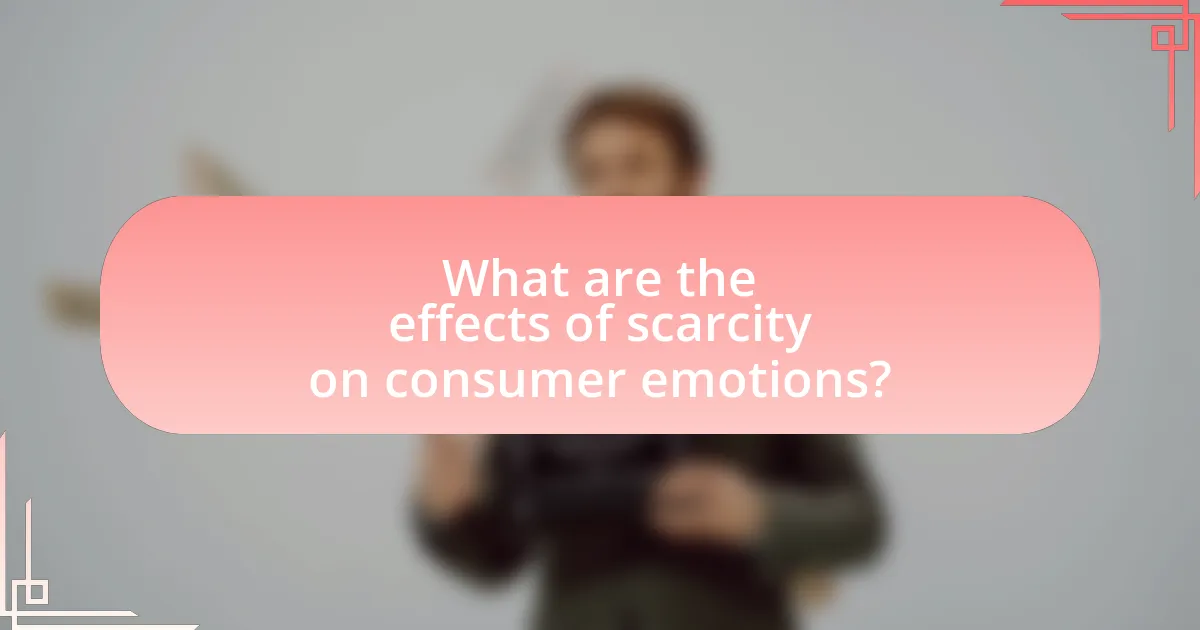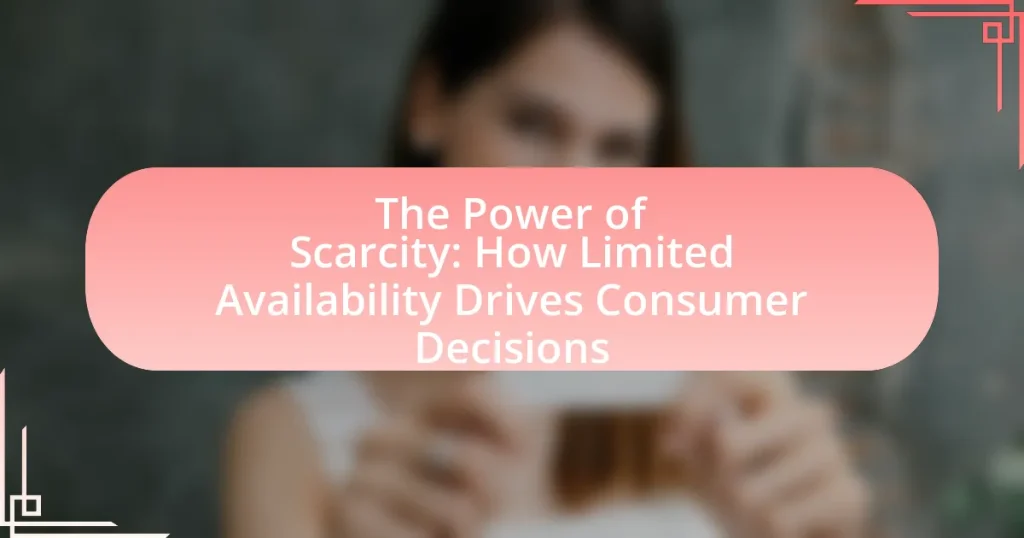The article “The Power of Scarcity: How Limited Availability Drives Consumer Decisions” examines the concept of scarcity in consumer behavior, highlighting its influence on decision-making and perceived value. It discusses psychological mechanisms triggered by scarcity, such as fear of missing out (FOMO) and urgency, which can lead to impulsive buying behavior. The article also explores various types of scarcity used in marketing, the ethical considerations surrounding its use, and best practices for businesses to implement effective scarcity strategies while maintaining consumer trust and satisfaction. Key metrics for measuring the effectiveness of scarcity tactics and common pitfalls to avoid are also addressed, providing a comprehensive overview of how scarcity impacts consumer choices and brand loyalty.

What is the concept of scarcity in consumer behavior?
The concept of scarcity in consumer behavior refers to the perception that a product or resource is limited in availability, which can significantly influence consumer decision-making. When consumers believe that a product is scarce, they often perceive it as more valuable and desirable, leading to increased urgency to purchase. Research by Cialdini (2009) in “Influence: Science and Practice” demonstrates that scarcity can create a sense of loss aversion, where consumers are motivated to act quickly to avoid missing out on a limited opportunity. This psychological response to scarcity drives demand and can lead to higher sales for products marketed as limited edition or in short supply.
How does scarcity influence consumer decision-making?
Scarcity significantly influences consumer decision-making by creating a perception of increased value and urgency. When consumers perceive that a product is limited in availability, they often feel compelled to act quickly to avoid missing out, leading to impulsive purchasing behavior. Research by Cialdini (2009) in “Influence: Science and Practice” demonstrates that limited supply can enhance desirability, as consumers associate scarcity with higher quality. This psychological trigger can result in higher sales and a willingness to pay premium prices for scarce items, as evidenced by the success of limited-edition products in various markets.
What psychological mechanisms are triggered by scarcity?
Scarcity triggers several psychological mechanisms, primarily the fear of missing out (FOMO), increased perceived value, and urgency in decision-making. FOMO arises when individuals believe that a limited resource may soon be unavailable, leading to anxiety and a heightened desire to acquire that resource. Increased perceived value occurs because scarcity often signals exclusivity, making items seem more desirable; for example, a study by Cialdini (2009) highlights how limited-time offers can enhance consumer interest. Urgency in decision-making is driven by the need to act quickly to secure scarce resources, which can lead to impulsive purchases. These mechanisms collectively influence consumer behavior by creating a sense of urgency and enhancing the attractiveness of limited availability.
How does scarcity affect perceived value?
Scarcity increases perceived value by creating a sense of urgency and exclusivity among consumers. When a product is limited in availability, individuals often perceive it as more desirable, leading to heightened demand. Research by Cialdini (2009) in “Influence: Science and Practice” demonstrates that people are more likely to want items that are scarce, as they associate limited supply with higher quality and uniqueness. This psychological response drives consumers to prioritize scarce items over those that are readily available, reinforcing the notion that scarcity enhances perceived value.
Why is scarcity a powerful marketing tool?
Scarcity is a powerful marketing tool because it creates a sense of urgency that compels consumers to act quickly. When products are perceived as limited in availability, consumers fear missing out, which can lead to increased demand and faster purchasing decisions. Research by Cialdini (2009) in “Influence: Science and Practice” demonstrates that people are more likely to desire items that are scarce, as scarcity triggers a psychological response that enhances perceived value. This phenomenon is further supported by a study published in the Journal of Consumer Research, which found that limited-time offers significantly boost sales by leveraging the fear of loss among consumers.
What are the different types of scarcity used in marketing?
The different types of scarcity used in marketing include time-based scarcity, quantity-based scarcity, and social scarcity. Time-based scarcity refers to limited-time offers that create urgency, prompting consumers to act quickly; for example, flash sales that last only a few hours. Quantity-based scarcity involves limiting the number of items available, such as a product being labeled as “only 5 left in stock,” which can increase perceived value and desirability. Social scarcity leverages the idea of exclusivity, where products are marketed as being popular or in high demand, such as “limited edition” items that appeal to consumers’ fear of missing out. These types of scarcity effectively drive consumer decisions by creating urgency and enhancing the perceived value of products.
How do marketers create a sense of urgency through scarcity?
Marketers create a sense of urgency through scarcity by limiting the availability of products or services, prompting consumers to act quickly to avoid missing out. This tactic leverages psychological principles, as research indicates that perceived scarcity increases desirability; for instance, a study published in the Journal of Consumer Research found that consumers are more likely to purchase items labeled as “limited edition” or “only a few left in stock.” By emphasizing limited quantities or time-sensitive offers, marketers effectively trigger fear of loss, motivating immediate consumer action.

What are the effects of scarcity on consumer emotions?
Scarcity significantly heightens consumer emotions, primarily inducing feelings of urgency and anxiety. When consumers perceive a product as limited in availability, they often experience a fear of missing out, which can lead to impulsive purchasing decisions. Research by Cialdini (2009) indicates that scarcity triggers a psychological response that prioritizes immediate action, as individuals associate limited resources with higher value. This emotional response can also manifest as increased excitement or desire for the product, reinforcing the notion that scarcity enhances perceived desirability.
How does scarcity impact consumer trust and loyalty?
Scarcity enhances consumer trust and loyalty by creating a perception of value and exclusivity. When products are limited in availability, consumers often perceive them as more desirable, leading to increased trust in the brand that offers them. Research indicates that scarcity can trigger a fear of missing out (FOMO), motivating consumers to act quickly and reinforcing their loyalty to brands that provide unique offerings. For instance, a study published in the Journal of Consumer Research found that consumers are more likely to trust brands that utilize scarcity tactics, as they associate limited availability with higher quality and prestige. This dynamic fosters a stronger emotional connection between consumers and brands, ultimately enhancing loyalty.
What role does fear of missing out (FOMO) play in consumer choices?
Fear of missing out (FOMO) significantly influences consumer choices by creating a sense of urgency and prompting immediate action. This psychological phenomenon drives individuals to make purchases to avoid the regret of missing exclusive opportunities, such as limited-time offers or scarce products. Research indicates that 60% of millennials report feeling FOMO, which directly correlates with impulsive buying behaviors. Additionally, a study published in the Journal of Consumer Research found that consumers are more likely to buy products when they perceive them as scarce, reinforcing the idea that FOMO can lead to increased sales and rapid decision-making in purchasing contexts.
How can scarcity lead to impulsive buying behavior?
Scarcity can lead to impulsive buying behavior by creating a sense of urgency and fear of missing out among consumers. When products are perceived as limited in availability, individuals often feel compelled to make quick purchasing decisions to avoid regret. Research indicates that scarcity triggers emotional responses, such as anxiety and excitement, which can override rational decision-making processes. For instance, a study published in the Journal of Consumer Research found that consumers are more likely to purchase items labeled as “limited edition” or “only a few left” due to the heightened perceived value and urgency associated with scarcity. This psychological phenomenon drives impulsive buying as consumers prioritize immediate acquisition over thoughtful consideration.
What are the ethical considerations of using scarcity in marketing?
The ethical considerations of using scarcity in marketing include the potential for manipulation and deception of consumers. When marketers create artificial scarcity, they may mislead consumers into believing that a product is more desirable or valuable than it actually is, which can undermine trust in the brand. Research indicates that perceived scarcity can lead to impulsive buying behavior, raising concerns about consumer autonomy and informed decision-making. For instance, a study published in the Journal of Consumer Research found that consumers are more likely to purchase items labeled as limited in quantity, even if they do not need them, highlighting the ethical dilemma of exploiting psychological triggers for profit.
How can misleading scarcity tactics harm brand reputation?
Misleading scarcity tactics can significantly harm brand reputation by eroding consumer trust. When brands falsely imply that products are in limited supply, customers may feel manipulated upon discovering the truth, leading to feelings of betrayal. Research indicates that 70% of consumers are more likely to abandon a brand after experiencing deceptive marketing practices. This loss of trust can result in negative word-of-mouth, decreased customer loyalty, and ultimately, a decline in sales. Brands that engage in such tactics risk long-term damage to their image, as consumers increasingly value transparency and authenticity in their purchasing decisions.
What are the potential consequences of overusing scarcity strategies?
Overusing scarcity strategies can lead to consumer skepticism and brand damage. When consumers frequently encounter artificial scarcity, they may begin to doubt the authenticity of the claims, resulting in decreased trust in the brand. Research indicates that excessive reliance on scarcity can cause consumers to feel manipulated, leading to negative perceptions and potential backlash against the brand. For instance, a study published in the Journal of Consumer Research found that consumers who perceive scarcity as deceptive are less likely to purchase from the brand in the future. Additionally, overuse can diminish the effectiveness of scarcity as a marketing tactic, as consumers become desensitized to such strategies, ultimately reducing their impact on purchasing decisions.

How can businesses effectively implement scarcity strategies?
Businesses can effectively implement scarcity strategies by creating limited-time offers or exclusive products that enhance perceived value. For instance, companies like Apple utilize product launches with limited availability to generate buzz and urgency, leading to increased consumer demand. Research indicates that scarcity can trigger a fear of missing out (FOMO), motivating consumers to act quickly; a study published in the Journal of Consumer Research found that limited availability can significantly increase purchase intentions. By strategically managing inventory and communicating scarcity through marketing channels, businesses can leverage this psychological principle to drive sales and enhance brand loyalty.
What best practices should businesses follow when using scarcity?
Businesses should create genuine scarcity by limiting product availability and clearly communicating this to consumers. This practice enhances perceived value and urgency, motivating quicker purchasing decisions. For instance, a study by Cialdini (2009) highlights that consumers are more likely to buy items labeled as “limited edition” or “only a few left,” as these phrases trigger a fear of missing out. Additionally, businesses should ensure that the scarcity is authentic; misleading consumers can damage trust and brand reputation. Implementing countdown timers for sales or showcasing low stock levels can effectively convey urgency while maintaining transparency.
How can businesses balance scarcity with customer satisfaction?
Businesses can balance scarcity with customer satisfaction by strategically managing product availability while ensuring that customers feel valued and engaged. Implementing limited-time offers or exclusive releases can create a sense of urgency, driving demand without alienating customers. For instance, brands like Apple successfully use scarcity by releasing products in limited quantities, which enhances desirability and maintains customer interest. Additionally, maintaining transparent communication about product availability helps manage customer expectations, fostering trust and satisfaction. Research indicates that perceived scarcity can enhance product value, as demonstrated in studies showing that consumers are more likely to purchase items they believe are in limited supply.
What metrics should businesses track to measure the effectiveness of scarcity tactics?
Businesses should track conversion rates, sales velocity, customer engagement, and inventory turnover to measure the effectiveness of scarcity tactics. Conversion rates indicate the percentage of visitors who make a purchase when scarcity is introduced, reflecting the tactic’s immediate impact on consumer behavior. Sales velocity measures how quickly products sell out, providing insight into demand generated by perceived scarcity. Customer engagement metrics, such as time spent on product pages or social media interactions, reveal how scarcity influences consumer interest and urgency. Lastly, inventory turnover rates help assess how effectively scarcity tactics drive sales relative to stock levels, indicating overall market responsiveness. These metrics collectively provide a comprehensive view of how scarcity tactics influence consumer decisions and business performance.
What are common pitfalls to avoid when leveraging scarcity?
Common pitfalls to avoid when leveraging scarcity include over-exaggerating the limited availability, which can lead to consumer skepticism and distrust. When businesses falsely claim that products are scarce, they risk damaging their reputation and losing customer loyalty. Additionally, failing to create genuine urgency can result in missed sales opportunities; consumers may not respond if they perceive the scarcity as artificial. Research indicates that authentic scarcity, such as limited-time offers or exclusive releases, is more effective in driving consumer action compared to fabricated scarcity. Lastly, neglecting to communicate the value of the scarce item can diminish its perceived worth, as consumers need to understand why the limited availability is significant.
How can businesses ensure authenticity in their scarcity messaging?
Businesses can ensure authenticity in their scarcity messaging by providing transparent and verifiable information about product availability. This involves clearly stating the limited quantity of items, using real-time inventory data, and avoiding exaggerated claims that could mislead consumers. For instance, a study by Cialdini et al. (2006) highlights that consumers are more likely to trust and respond positively to scarcity messages when they are backed by factual data, such as “Only 5 items left in stock.” This approach not only builds trust but also enhances the effectiveness of scarcity as a marketing strategy.
What strategies can mitigate negative consumer reactions to scarcity?
To mitigate negative consumer reactions to scarcity, businesses can implement transparent communication, enhance perceived value, and offer alternatives. Transparent communication involves informing consumers about the reasons for scarcity, which can reduce frustration and build trust. Enhancing perceived value can be achieved through marketing strategies that emphasize exclusivity and quality, making consumers feel that the limited product is worth the investment. Offering alternatives, such as pre-orders or waitlists, allows consumers to feel included in the purchasing process, even when the desired item is unavailable. Research indicates that clear communication and perceived value can significantly influence consumer satisfaction and loyalty, even in scarcity situations.
What practical tips can businesses apply to harness the power of scarcity?
Businesses can harness the power of scarcity by implementing limited-time offers, exclusive products, and countdown timers. Limited-time offers create urgency, prompting consumers to act quickly; for example, a study by the Journal of Consumer Research found that consumers are more likely to purchase items when they perceive them as scarce. Exclusive products, such as limited edition items, enhance desirability and can lead to increased sales, as evidenced by brands like Nike and Supreme, which often release products in limited quantities to drive demand. Countdown timers on websites can visually reinforce scarcity, leading to a 9% increase in conversion rates, according to research by HubSpot. These strategies effectively leverage the psychological principle of scarcity to influence consumer behavior.


